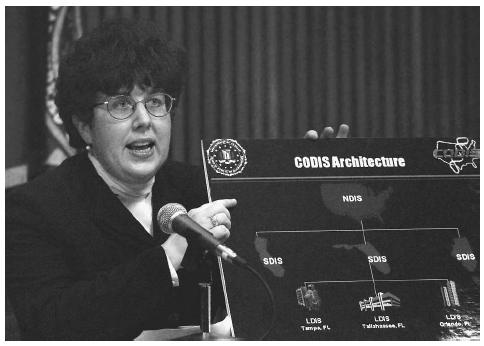DNA
█ JULI BERWALD
Because of the uniqueness of every human's DNA and the ubiquity of DNA in cells, this genetic molecule has become an important tool for the identification of individuals, both in forensics and security applications. Deoxyribonucleic acid (DNA) consists of two twisted strands of polymers, made up of mononucleotide units. Each nucleotide is composed of three separate parts: a 2-deoxyribose sugar ("2-deoxy-" because the hydroxyl or -OH group of the ribose sugar is missing from the second carbon position on the sugar ring), a phosphate, and one of the four bases: adenine (A), guanine (G), cytosine (C), thymine (T). The deoxyribose sugar and phosphate are linked by phosphodiester bridges in such a way as to form an unbranched polynucleotide chain. According to the Watson-Crick model, which was published in 1953, the DNA molecule consists of two such polynucleotide chains which are complementary but not identical and which spiral around an imaginary common axis. The two strands are antiparallel, meaning that the phosphodiester links between the deoxyribose units read in opposite directions designated 5' to 3' on one chain and 3' to 5' on the other. The bases, which are perpendicular to the helix axis, protrude at regular intervals from the two spiral sugar phosphate strands, and reach into the interior of the helix. The strands are annealed together by hydrogen bonds between the bases of opposite strands and for correct annealing to occur a purine (adenine or guanine) on one strand must pair with a pyrimidine (thymine or cytosine) on the other. Within the constraints of the double helix, hydrogen bonds can only form between adenine and thymine (A:T) and between guanine and cytosine (G:C). Through this pairing, the arrangement of bases along one strand determines that of the other and the genetic information is thus coded in these base sequences.
The most commonly described DNA structure is that of the right-handed Watson-Crick double helix, also known as B-DNA, which has a diameter of 20Å. The double helix is not symmetrical and has a broad groove and a narrow groove between the chains, known respectively as the major and minor grooves. Adjacent bases are separated by 3.4Å along the helix axis and related by a rotation of 36° which causes the helix structure to repeat after 10 residues on each chain, that is at intervals of 34Å. DNA is, however, a dynamic molecule whose structure can vary and there are two other commonly found DNA conformations, each with slightly different dimensions.

The DNA molecule contains all of the genetic information for every organism. Within a cell, DNA is organized into long strands called chromosomes. Every chromosome contains many thousands of different genes. A gene is a functional segment of DNA that codes for a specific protein. During protein synthesis, a portion of DNA is translated into a complementary strand of ribonucleic acid (RNA), which is further transcribed into a sequence of amino acids. A sequence of three nucleotides is required to code for one amino acid and chains of amino acids are further modified outside the nucleus of the cell into the proteins. There are approximately 50,000 different types of proteins in the human body and they either perform tasks or synthesize molecules required for the biological activity that sustains life. The DNA in every individual, therefore, is the source of information the directs all of the biological functions in the body.
The DNA molecule is inherited by every cell and every individual. In asexual reproduction, the DNA in chromosomes is unwound and duplicated before the cell divides. Both daughter cells receive exact copies of the parent cell's DNA. In sexual reproduction, a portion of the DNA is inherited from both the female and the male parent. In humans, there are 23 pairs of chromosomes in the genome. During meiosis, which forms the sex cells or gametes (the egg in females and the sperm in males), the chromosomal pairs separate and each gamete receives 23 unpaired chromosomes. When a sperm fertilizes an egg, its 23 unpaired chromosomes are paired with the 23 unpaired chromosomes in the egg and the resulting zygote contains a unique set of paired chromosomes.
Comment about this article, ask questions, or add new information about this topic: